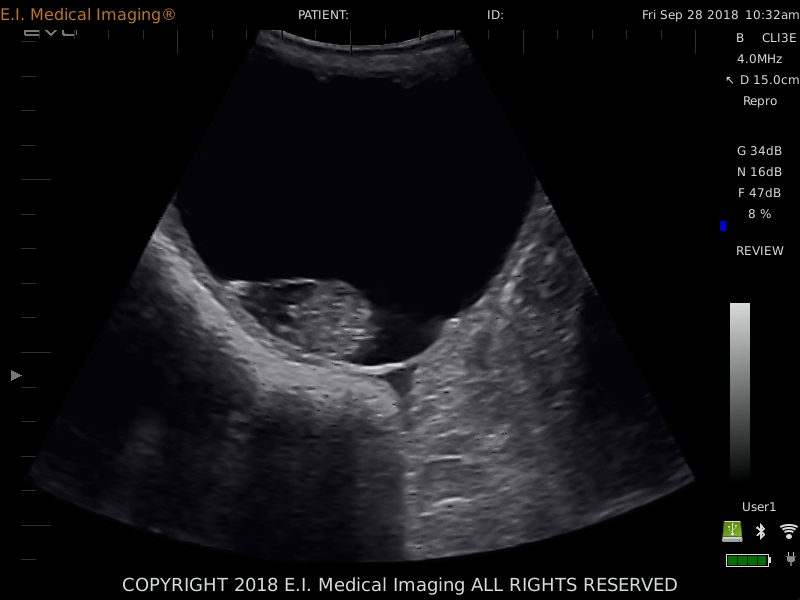
On a recent bikepacking trip in the UK, E.I. Medical Imaging staff vet Dr. Erika Wierman had this charming encounter...
By Erika Wierman, DVM on Tue, Aug 06, 2019 @ 08:25 AM

On a recent bikepacking trip in the UK, E.I. Medical Imaging staff vet Dr. Erika Wierman had this charming encounter...
By Erika Wierman, DVM on Tue, Jul 09, 2019 @ 08:31 AM

As a veterinarian, you’re trained to understand what you see on an ultrasound machine, but your equine client may be baffled by the images. They may not even know what ultrasound imaging actually is or does, or its value as a diagnostic tool. Here are some tips for explaining ultrasound images to horse owners.
By Erika Wierman, DVM on Tue, Apr 30, 2019 @ 07:54 AM
Image: IBEX® EVO® + L7HD, in a Holstein cow
Mummification in bovine fetuses has an incidence of less than 2%. It occurs when there is fetal death for any number of reasons (Trichomoniasis and BVD infections have been specifically implicated as causes), but the CL is retained, the cervix stays closed, and there is no bacteria or oxygen present in the uterus to cause maceration.
By Erika Wierman, DVM on Fri, Mar 22, 2019 @ 08:35 AM
Last month I had the pleasure of teaching at the Colorado VMA’s small ruminant meeting, and it got me thinking about some of the common misconceptions and mistakes made when using ultrasound to diagnose pregnancy in sheep and goats. I thought I might take this opportunity to highlight my top five tips.
By Erika Wierman, DVM on Mon, Mar 11, 2019 @ 03:46 PM
With our next generation EVO® II and FASTVet™, you can be using ultrasound EVERY DAY in your companion animal practice!
With FASTVet™ techniques, you don’t need to be an expert sonographer to assess and monitor your patients. These are standardized, goal-directed exams that any veterinarian can easily learn and implement. Built-in procedural videos provide immediate assistance in performing FASTVet™ protocols. And in emergencies, no other tool offers such unparalleled, exigent diagnostic assistance.
By Erika Wierman, DVM on Tue, Feb 05, 2019 @ 02:38 PM
All ultrasounds have gain control. It’s often a knob, button, and/or a series of sliders on the console, and it’s one of the most used and adjusted scanning parameters... but do you know what it really does?
Most people think of gain as a brightness adjuster, and while it’s true that turning your gain up will brighten the image, it’s helpful to understand how it actually works. Gain is a uniform amplification of the ultrasonic signal that is returning to the transducer after it travels through the tissue. So rather than brightening the monitor, the image on the screen is whitened by a uniform margin, as though the returning signal is stronger than it is, to make it easier to see.
By Erika Wierman, DVM on Fri, Jan 18, 2019 @ 08:19 AM
 There are an overwhelming number of transducer (probe) options on the market these days, marketed for different species and applications. What do you need to consider when selecting one? Whether you are shopping for a new system or transducer, or simply deciding which of your current probes to use for a specific purpose, here are a few tips to keep in mind.
There are an overwhelming number of transducer (probe) options on the market these days, marketed for different species and applications. What do you need to consider when selecting one? Whether you are shopping for a new system or transducer, or simply deciding which of your current probes to use for a specific purpose, here are a few tips to keep in mind.
By Erika Wierman, DVM on Sun, Jan 06, 2019 @ 03:02 PM
 You’ve probably noticed that the transducers, or probes, on your ultrasound system are named or marked with a number followed by ”MHz”, most likely in the 1-20 range. Often this is how a company advertises their products – for example, a 7MHz linear rectal transducer. Perhaps you’ve wondered what this number refers to or the significance of having a higher or lower number on your probe.
You’ve probably noticed that the transducers, or probes, on your ultrasound system are named or marked with a number followed by ”MHz”, most likely in the 1-20 range. Often this is how a company advertises their products – for example, a 7MHz linear rectal transducer. Perhaps you’ve wondered what this number refers to or the significance of having a higher or lower number on your probe.
By Erika Wierman, DVM on Tue, Dec 11, 2018 @ 02:58 PM
If you’re new to ultrasound, an image may look like nothing more than a swirling array of grey tones on the screen. Interpretation requires an understanding of anatomy and physiology, but also of how ultrasound technology functions.
Consider the sonar produced by a bat in flight. The bat emits high frequency sounds, which then bounce off of objects in its proximity and return to the bat. The animal uses the strength, direction, and timing of the returning sound to determine where those objects are and to avoid a collision.
By Erika Wierman, DVM on Sun, Oct 14, 2018 @ 02:45 PM
Have you ever looked at an ultrasound image and wondered what are you looking at? Ever wonder which end is up? When others are discussing bull or heifer, ovarian diagnosis, or metritis treatment are you still looking to decide what it is?? Well, if you feel left in the dark when it comes to ultrasound images…..let’s start back at the basics.
Ultrasound is a non-invasive, immediate tool used to image tissue. It will not penetrate bone (like an X-Ray). So the first step to help you read the ultrasound image is to be familiar with the anatomy that you are imaging.
To learn more about our veterinary ultrasound platforms or to schedule a free demo, click here or call 1.866.365.6596
Trade-in to Trade-up get credit for any ultrasound when you trade up to IBEX premium veterinary ultrasound
Retool to Upgrade breathe new life into out-of-warranty IBEX PRO or LITE to upgrade to our latest technology
We design and manufacture IBEX veterinary ultrasound systems, portable and rugged for anywhere you need to go.
[fa icon="phone"] 1.866.365.6596
[fa icon="envelope"] info@eimedical.com